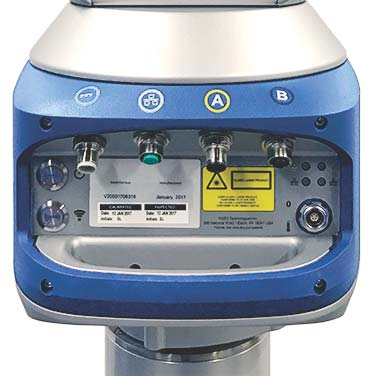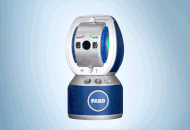Laser Safety Classification for the Laser Tracker
Overview
Eye safety and laser safety information for FARO® Laser Trackers is defined by laser beam emission technical specifications, such as the laser beam safety classification, wavelength range, and output power. The laser emissions label on the back of all FARO Laser Trackers provides the laser beam technical specifications.

You can also find more information and technical specifications in the Laser Tracker User Manual. Click here and look for your Laser Tracker model to download the appropriate user manual, then review chapters 1 and 2.
Laser Tracker operators and bystanders are not required to wear protective gear when close to the Tracker or when using it. However, you should avoid direct exposure to your eye at all times even though the human blink reaction to bright light provides a natural mechanism of protection to the visible laser beam.
FARO VantageS or VantageE Laser Trackers
These Laser Trackers emit a Class I red laser beam that has a wavelength of 637 nm and a maximum output of 390 microwatts .
FARO Vantage or ION® Laser Trackers
These Laser Trackers emit a Class II red laser beam with a maximum output of 1 milliwatt.
- The Vantage Laser Tracker laser beam has a wavelength range between 632 and 663 nm.
- The ION X, Xi, and SI Trackers' laser beams have a wavelength range that is Helium-Neon (HeNe) 633 nm.
The Absolute Distance Meter (ADM) system for both the Vantage and ION Laser Trackers emits a Class I laser beam that has wavelength range of 1550 nm and a maximum output of less than 0.79 milliwatts.
The FARO Laser Tracker is a classified as a Class II laser product and meets the requirements of the Food and Drug Administration, Center for Devices and Radiological Health, Register 21 CPR parts 1000 and 1040, and those of international standard IEC EN 60825-1 2001-08.
There is no certifying body for IEC 60825 so we (or other manufacturers of laser based equipment) do not receive any certificates of compliance. We receive periodic accession reports from the Center for Devices and Radiological Health (CDRH) based off safety reports that were provided to them during the design of the tracker. Attached is a portion of the initial safety report that was filed with the CDRH at original design of this series. Although the tracker has improved in performance and accuracy resulting in the X, Xi and ION series releases, none of the laser powers or wavelengths has changed.
Note: The full report contains assembly drawings of certain internal components of the tracker and cannot be released.
Click here to download: Laser Tracker Classification and Safety Report
Keywords:
laser beam strength, laser beam output, laser beam wave length range, eye safety

